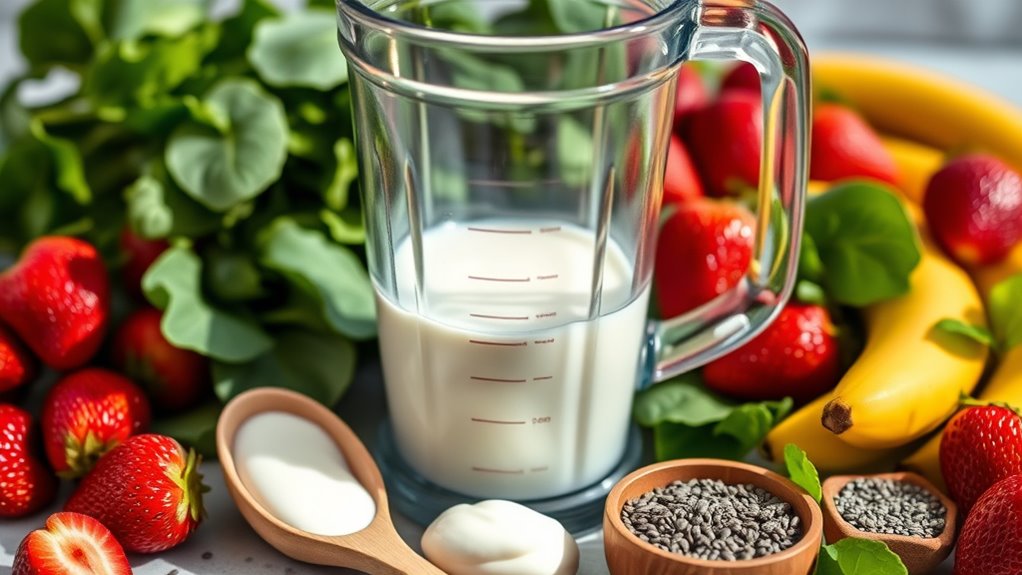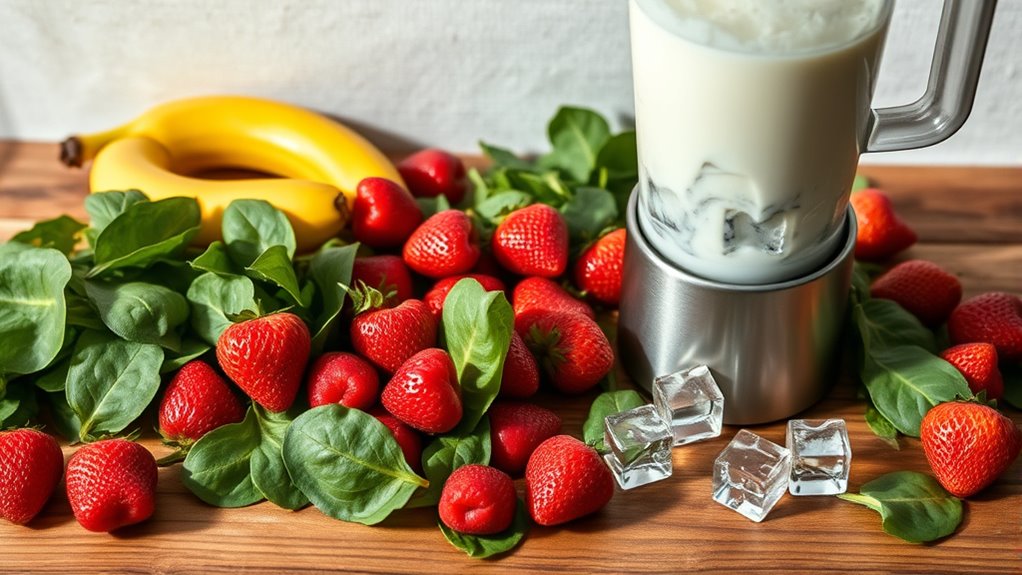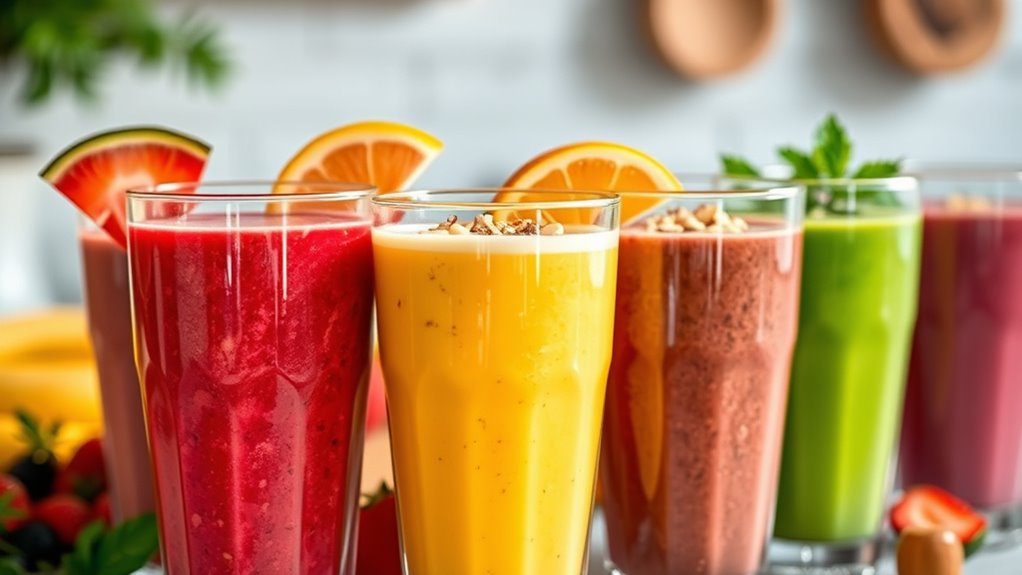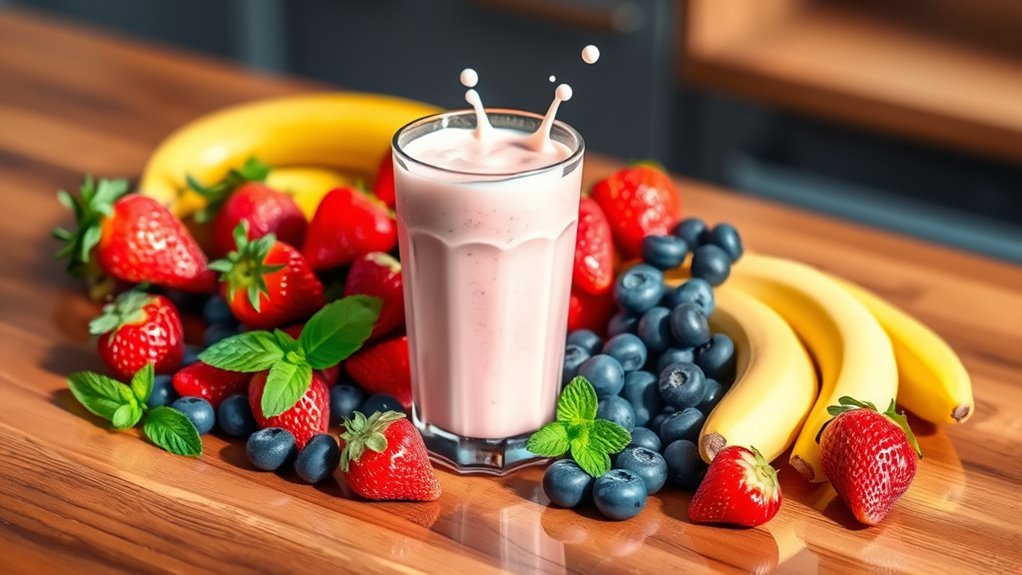To make a delicious milk and fruit smoothie, start by measuring about one cup each of your chosen fruit and milk or alternative like almond or oat milk. Wash and cut fruits evenly, then blend by adding liquids first, followed by softer fruits, and ice last for the best texture. Serve immediately in clear glassware, garnished with fresh fruit or nuts for extra flair. Balancing sweet and tart flavors enhances taste, and using frozen fruit thickens without ice. Exploring detailed tips will help you perfect your blend.
Ingredients and Quantity

When preparing your smoothie, it’s vital to measure ingredients accurately to achieve the desired texture and flavor. Selecting the right fruit combinations and milk alternatives impacts both taste and nutritional balance. For a smooth blend, typically use 1 cup of fruit and 1 cup of liquid per serving. Milk alternatives like almond, oat, or soy milk provide variety and accommodate dietary preferences without compromising creaminess.
| Ingredient | Quantity per Serving |
|---|---|
| Mixed berries | 1 cup |
| Banana | 1 medium |
| Almond milk | 1 cup |
This balance guarantees your smoothie isn’t too thick or watery, giving you freedom to customize while maintaining consistency. Accurate measurements help you enjoy a perfect blend every time.
Preparations

Before blending, you’ll need to properly prepare your ingredients to secure the best texture and flavor. Effective preparation techniques include washing fruits thoroughly, peeling when necessary, and cutting into uniform pieces to guarantee even blending. For smoothie variations involving frozen fruits, pre-chilling or lightly thawing helps maintain consistency. Using ripe fruits enhances natural sweetness, reducing the need for added sugars. If you’re incorporating leafy greens or nuts, consider soaking or softening them to improve blendability and nutrient absorption. Measuring ingredients accurately supports balanced flavor profiles and consistent results. By mastering these preparation techniques, you gain freedom to experiment confidently with various smoothie variations, creating nutritious blends tailored to your taste and dietary needs, all while optimizing texture and flavor for a satisfying smoothie experience.
How to Prepare

- Gather all your ingredients and tools within reach, ensuring you have a clean blender and appropriate measuring utensils.
- Select your preferred smoothie variations, such as tropical fruits or berry blends, based on your taste and nutritional goals.
- Measure ingredients accurately to maintain consistency and balance flavors.
- Add liquids to the blender first, followed by softer fruits, then ice or frozen components to optimize blending.
- Start blending by pulsing initially to break down solids.
- Continue blending until the mixture is smooth, avoiding over-blending to preserve texture and nutrients.
- Customize your smoothie as desired to ensure a delicious and nutrient-rich result every time without unnecessary hassle or waste.
How to Serve

Once your smoothie reaches the perfect consistency, serving it properly enhances both its appeal and nutritional value. Considering various presentation styles can elevate your experience and encourage mindful consumption. Here are three effective serving suggestions:
- Use clear glassware to showcase the vibrant colors, which stimulates appetite and enjoyment visually.
- Garnish with fresh fruit slices or a sprinkle of nuts to add texture and a nutritional boost.
- Serve immediately after blending to retain maximum nutrient density and ideal flavor.
These presentation styles not only make your smoothie more inviting but also support your body’s absorption of vitamins and minerals. By focusing on how you serve, you embrace freedom in your food choices while maximizing health benefits.
Tips

Although blending a great smoothie can seem straightforward, applying a few key tips can greatly improve both texture and flavor. First, consider your ingredient substitutions carefully; swapping yogurt for milk, for example, can create a creamier texture without adding excess sugar. When experimenting with smoothie variations, balance sweet and tart components to maintain a revitalizing taste. Use frozen fruit to achieve a thicker consistency without diluting flavor with ice. Additionally, blending order matters—start with liquids, then softer ingredients, and finish with frozen items to avoid clumping. Don’t hesitate to customize based on your preferences and dietary needs; this freedom allows you to create smoothies that suit your lifestyle perfectly. These evidence-based techniques guarantee each blend is both enjoyable and satisfying.
Food Value and Benefit
This smoothie is a nutrient-dense beverage that combines fruits, leafy greens, and milk, providing a balanced mix of vitamins, minerals, protein, and fiber.
Food Value:
- Rich in vitamins: Vitamin C (from fruits), Vitamin A (from leafy greens and fruits)
- Contains essential minerals: Calcium (from milk), Potassium (from fruits and greens)
- Provides protein (from milk)
- High in dietary fiber (from leafy greens and fruits)
- Contains carbohydrates (from fruits) for energy
Benefits of Eating This Smoothie:
- Supports bone health and strengthens the immune system due to calcium and vitamin C content
- Enhances digestion and promotes sustained energy through increased fiber intake
- Helps stabilize blood sugar levels by balancing carbohydrates and protein, reducing the risk of energy crashes
- Provides antioxidants from vitamins A and C, which contribute to overall wellness and cellular health
